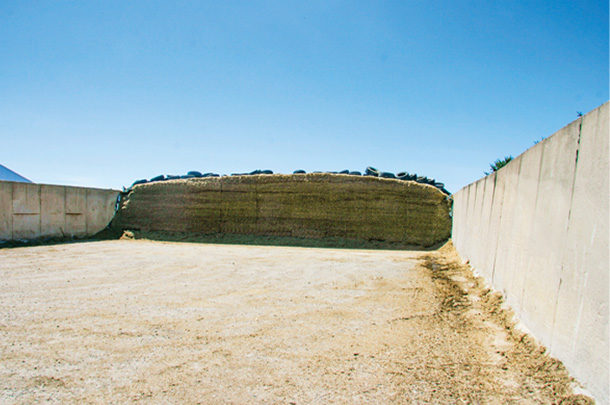Maximizing your silage space can allow producers to – quite literally – pack more tons of valuable feed into the same space. With a little advance planning, the result can be thousands of dollars more in feed without any additional real estate.
Space for silage storage is a hot commodity nearly everywhere in the U.S. Often, the perfect location for ensiling doesn’t exist. Producers need to make great silage in all kinds of conditions. The good news is: It’s possible.
Get the team together
With the high price of feed, it can really pay to focus on the details. A 30-minute pre-harvest planning meeting with the forage harvest team can help get everyone on the same page. Do it right, on purpose.
At the planning meeting, discuss staging the harvest timing from a crop maturity perspective. This applies to corn silage as well as alfalfa and triticale silage. Other details to consider discussing include pack density, moisture, kernel processing, and cut length expectations and goals. We often recommend putting a person in charge of monitoring these variables throughout the process. Small variations in moisture can affect pile density, fermentation efficiency and cause challenges at feedout. Making small tweaks throughout the duration of harvest can be critical to ensuring a high-quality and hygienic feed.
Nail harvest timing
Harvesting at the optimal plant moisture and dry matter (DM) will help set the stage for high-quality feed. Of course, the perfect timing greatly depends on the weather. A timely harvest will ensure crop nutrients are captured and enable packing operations to be more effective. Harvest delays or missing the optimal harvest window will drive nutrient losses and impact fermentation efficiency. Timing is the first step toward maximizing the quality of resulting feedstuffs.
Watch out for contamination
Keep an eye on ash contamination that can result from dirty tires or front-end loaders scraping the ground. Silage storage area limitations – or misjudging the pile size and building space – can often mean forage is dumped on the bare ground. Inevitably, this sometimes results in scraping a tractor scoop on the ground to retrieve the forage, except now you’re also getting a healthy dose of soil contamination and bad microbes. Poor drainage around the silo, especially around the feeding face, can make this issue worse.
Keep a log of key metrics like ash content from the forage analysis, feed intake and silage stability in the feedbunk. These measurements can help determine if additional investments in space or concrete are justified.
Ferment efficiently
Getting a fast initial fermentation helps the silage reach a low, stable pH. This alone can help address a lot of challenges. The calculations on inoculant investment – spread over the cost per head per day – are easily justified by the ROI provided by reputable products.
A research-proven inoculant strain, such as Pediococcus pentosaceus NCIMB 12455, can help drive a fast, efficient fermentation. In addition, some inoculants can contribute high-activity enzymes that help break down plant fiber, which can improve fiber digestibility and feed utilization. More significant challenges – including excessive spoilage losses, unstable silage and suboptimal harvest conditions – may require a combination inoculant.
Plan for every inch
Let’s be honest: Most producers are ballparking their silage space. We can probably get a few more feet with deliberate measuring and planning. The ideal pile size allows producers to remove 6 inches of silage from the face of the pile each day. This rate helps minimize spoilage due to exposure to air.
Producers can gauge their ideal pile size based on feeding needs using calculators from the University of Wisconsin Extension (Forage/Harvest).
For many operations, space is limited. These producers can determine the pounds of silage available in the space allotted using the calculation:
Width × Length × Average height × As-fed density
Next, we can add more potential feedstuffs by building sides with optimal slopes. A shallow pile is typically less than 16 to 18 degrees. With steeper sides, we can create more density and store more pounds of feed.
Never build an unsafe pile. Always build so the unloading equipment can safely reach the top of the pile. Always maintain slopes at a 3-to-1 or 4-to-1 run to rise on the sides and ends of a drive-over pile.
A quick checklist to consider when planning a silage space includes:
- Is there appropriate drainage?
- Can a 2% slope be created to improve drainage?
- Is the pile at least 100 feet away from wells?
- Will the silage face be accessible in inclement weather?
- Will the face open to the sun?
- Is the pile easy to maneuver around?
- Is the location too far away?
- Is the pile built on optimal flooring?
Many times, producers put their silage on dirt. Investing in a pad can help reduce contamination and improve the operation’s ease of access.
Pack it tight
Focusing on density can help overcome most of the challenges discussed. It will seemingly magically allow producers to take the same space and stuff it with more high-quality, valuable feedstuffs.
The average density of corn silage piles is far below the target, sitting at around 13 to 14 pounds of DM per cubic foot throughout the whole pile. A 2004-05 study of Pennsylvania bunkers and piles showed there was significant room for improvement in packing practices. The average density ranged from 11.6 pounds of DM per cubic foot at the top of the pile to just 14.6 pounds of DM per cubic foot at the bottom of the bunker level.
The sweet spot for maximum density should really be between 17 to 20 pounds per cubic foot. Increasing the density in the same given space could give producers up to 40% more silage. Yes, that’s a huge number. It’s possible by more densely packing the forage. These percentages are not considering the improved nutrient recovery producers can experience with a well-packed silage pile.
Adding one or more heavy tractors can help improve packing density. Packing weight should align with the rate of delivery. The top level of a pile is always the least well packed. This area is more likely to be exposed to runoff and oxygen. Optimal pack density is achieved by spreading each layer out in less than 6-inch layers. Too often, tractor load size exceeds the space available to distribute the load in thin layers. This results in the load being dropped at the top of the pile.
Make safety the priority
A taller, steeper silage pile can be more dangerous. Make sure employees understand all the safety rules at the operation. Reinforcing these rules and paying close attention during the hectic harvest time is important – especially when trying to maximize every inch of silage space available.
References omitted but are available upon request. Click here to email an editor.










